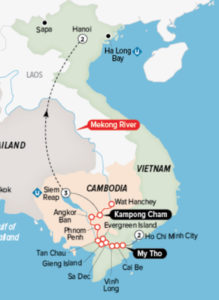March 1, 2018
We’re off at 0830 for our market and street food tour with Chef Thân. We 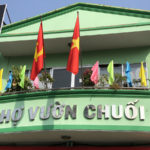 started our journey to the small permanent market Cho Vuon Chuoi in the 10th quarter. The side streets were lined with vendors and these were refered to as quick markets where people could ride up stop and get what they required for the day without the need to get off their scooter and park. The market was as expected narrow alleys with vendors on both sides selling fruits, vegetables, rice, noodles, and the list was extensive. First stop for a sample was the fresh spring being made by a vendor for the days sales. Rice paper
started our journey to the small permanent market Cho Vuon Chuoi in the 10th quarter. The side streets were lined with vendors and these were refered to as quick markets where people could ride up stop and get what they required for the day without the need to get off their scooter and park. The market was as expected narrow alleys with vendors on both sides selling fruits, vegetables, rice, noodles, and the list was extensive. First stop for a sample was the fresh spring being made by a vendor for the days sales. Rice paper filled with pork, shrimp, lettuce and garlic chives. Along the way we sampled fried bananas and sweet poatoes
filled with pork, shrimp, lettuce and garlic chives. Along the way we sampled fried bananas and sweet poatoes 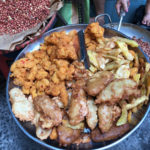 which were dipped and fried as we waited. I was able to get a great deal of information from the chef about various vegetables and herb and combinations.
which were dipped and fried as we waited. I was able to get a great deal of information from the chef about various vegetables and herb and combinations.
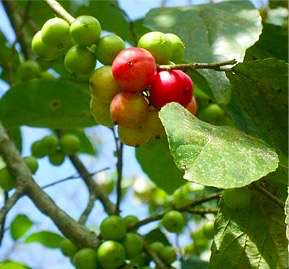
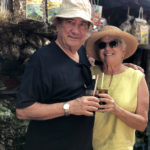 A quick stop for an energy drink of tea made with various herb and a sugar cane syrup with gave the drink a taste of a hint of mollassas. Next stop was for breakfast at a woman who made home-made rice cake, similar to too but far more flavorful. She prepared the
A quick stop for an energy drink of tea made with various herb and a sugar cane syrup with gave the drink a taste of a hint of mollassas. Next stop was for breakfast at a woman who made home-made rice cake, similar to too but far more flavorful. She prepared the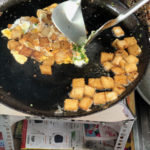 dish outside her home on a small flatish wok and sauted the rice cake with eggs. It was served with green papaya on top
dish outside her home on a small flatish wok and sauted the rice cake with eggs. It was served with green papaya on top 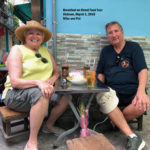 and a chili dipping sause which we added additional chili to. We also had traditional ice coffee with sweetend condensed milk which gave the coffee a chocolate milk like taste.
and a chili dipping sause which we added additional chili to. We also had traditional ice coffee with sweetend condensed milk which gave the coffee a chocolate milk like taste.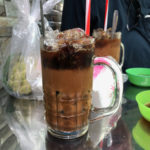
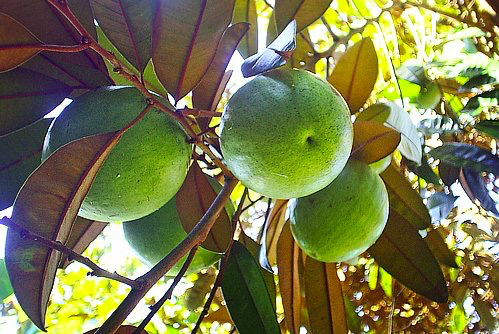
After the meal Thận ran off and came back with several fruits to small in addition to our cherimoya (custard apple)which resembled an artickoke in appearance. We had small fruits that looked like cherry tomatios but hade a sweet sour taste, lovi-lovi. We also tried Star Apple which has a soft and sticky center and was very flavorful.

Then we were off again this time we stopped for some Vietnamese sweet soup (Che). There are hundreds of variations but this one was made with Longon juice, Lotus root, seaweed, water chestnuts, and longan fruits. Pat and I asked to share, it was very sweet and an experience.
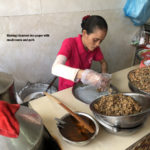 More food, we stopped to watch a woman making steamed rice paper and filling with meat, amd chopped mushrooms and we sampled a plate served with a sauce and lettuce and mung bean sprouts.
More food, we stopped to watch a woman making steamed rice paper and filling with meat, amd chopped mushrooms and we sampled a plate served with a sauce and lettuce and mung bean sprouts.
Next stop charcol roasted bananas, the bananas are peeled and partically dried in the sun the sopped in salt water and roasted over charcoal. It makes the exterior a bit leathery and the inside soft and creamy.
Wok roastered Peanuts with salt and ask, simply tastes like a reasted peanut. The peatuts are mixed with salt and charcoal ask which acts like and oven so they can be cooked in the wok.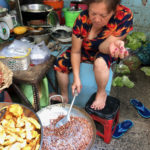
Off to view the flower market Ho Thi Ky
-
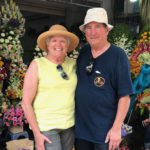 Street Food and Market TourSee images »
Street Food and Market TourSee images »
Next stop lunch at Quán Ǎn: Cȏ Liêng, a tiny restaurant frequented by the locals. They served roast pork, minced roasted pork and 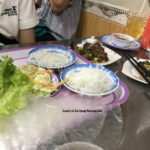 roasted pork in bettlenut leaves. You use rice paper and lots of lettuce and herbs and dip in a banana flavored sauce. Outstanding! Tham concluded our tour and back to the hotel.
roasted pork in bettlenut leaves. You use rice paper and lots of lettuce and herbs and dip in a banana flavored sauce. Outstanding! Tham concluded our tour and back to the hotel.
Pool time! We laid around the pool and went in several times to cool off for a few hours to decompress!
Tonight were on the hunt for pizza, and then off to bed.
We went to Nano Italian for dinner of focaccia, fruit mist, pizza with chorizo and a couple glasses of beer; I think you can tell were looking forward to some good western style food.
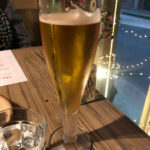


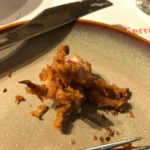
Wake up time is 0430 tomorrow.
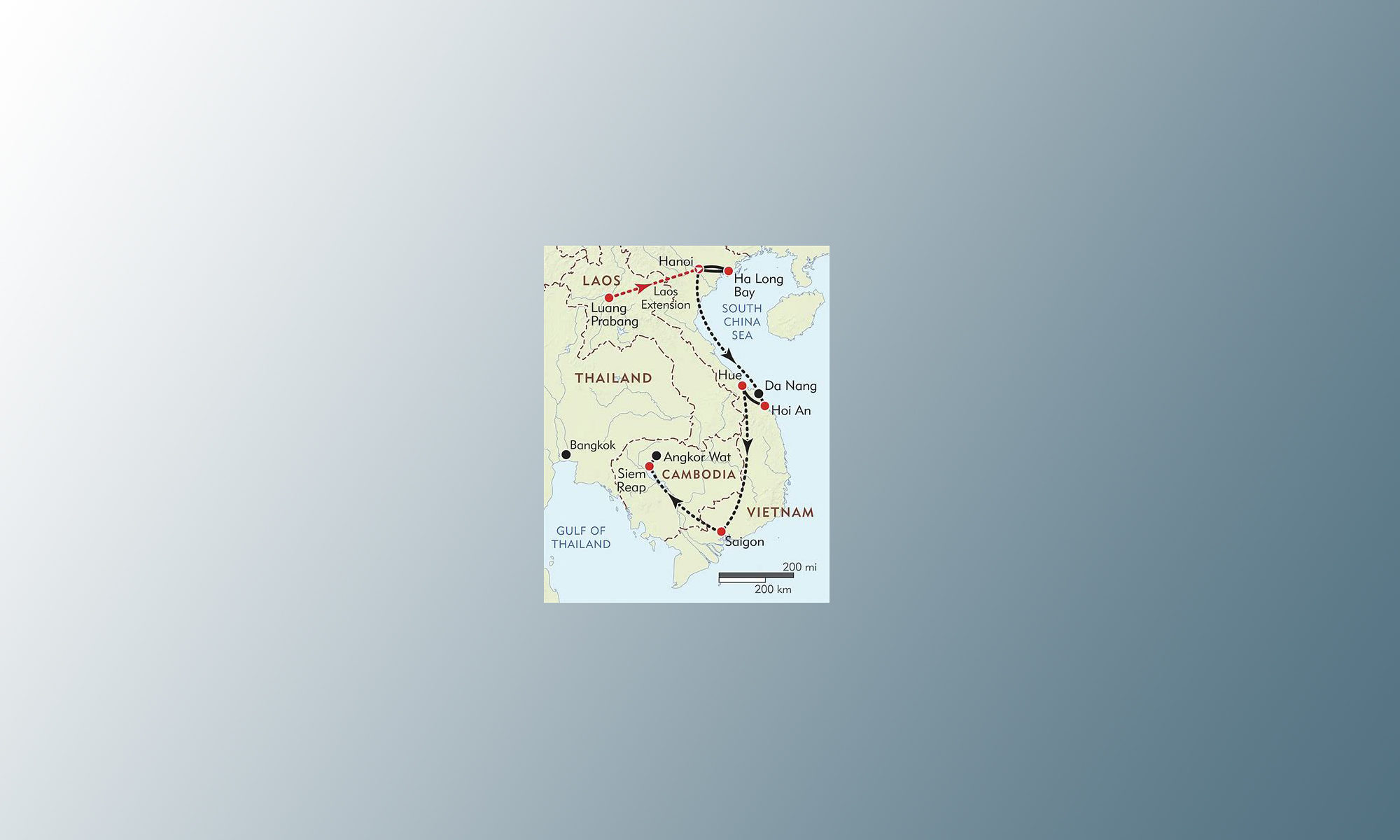

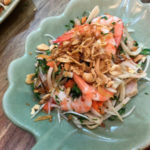





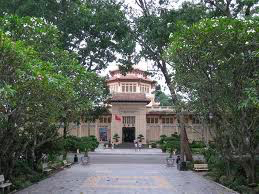

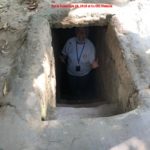

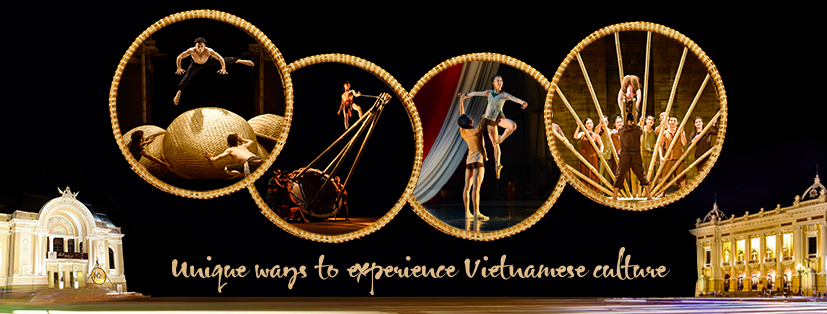
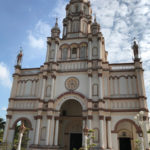
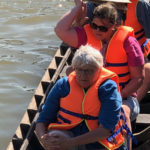 We left the ship at 0840 for the 15 minute sanpan ride to the island, the island is 50 square miles and a population od 50,000 people. We boarded a 6 person
We left the ship at 0840 for the 15 minute sanpan ride to the island, the island is 50 square miles and a population od 50,000 people. We boarded a 6 person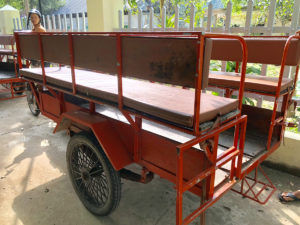
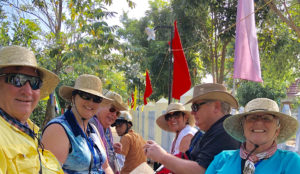 tim-tuk and drove to one of the 3 Cathloic churches on the island. As was past local sops and houses it was appearant that thia is a successful island. We toured the church and had a brief Q&A by the Franciscan priest, dressed in street clothes. He is also a physician specialing in leprosey and shin disorders and has been on the island for 40 years. We say our good bye with his blessing and continured by tsk-tuk to a manago orchard to see how the people
tim-tuk and drove to one of the 3 Cathloic churches on the island. As was past local sops and houses it was appearant that thia is a successful island. We toured the church and had a brief Q&A by the Franciscan priest, dressed in street clothes. He is also a physician specialing in leprosey and shin disorders and has been on the island for 40 years. We say our good bye with his blessing and continured by tsk-tuk to a manago orchard to see how the people 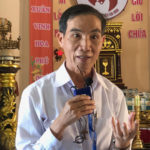 grow and harves mangos. The mangos that are of high quality are pagged during the growing season to keep them near perfect foe export at a very high price with Japan paying
grow and harves mangos. The mangos that are of high quality are pagged during the growing season to keep them near perfect foe export at a very high price with Japan paying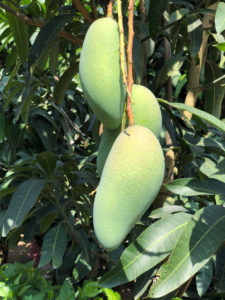 the highest. They are also exported to the US, Canada and Australia.
the highest. They are also exported to the US, Canada and Australia.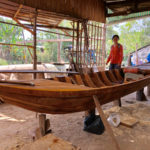 from Golden oaks which grow on the islan and ate 40-50 foot all buy slender. When on is cut more are planted. The grandfather was dilligently work on bending a lenght of oaks heating over fire for the fibers to be flexible enought to bend with out breaking.
from Golden oaks which grow on the islan and ate 40-50 foot all buy slender. When on is cut more are planted. The grandfather was dilligently work on bending a lenght of oaks heating over fire for the fibers to be flexible enought to bend with out breaking.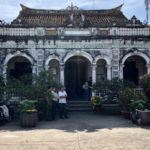

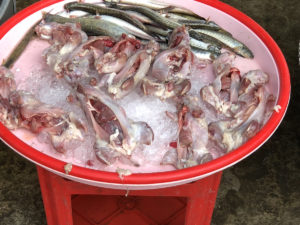
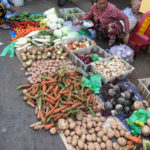
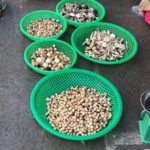


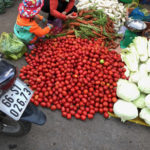

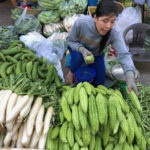
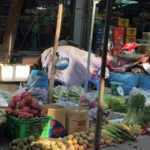

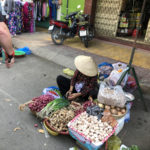
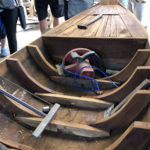
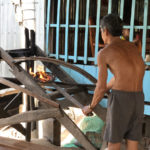
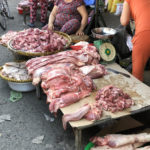





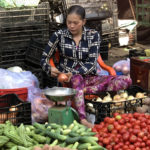

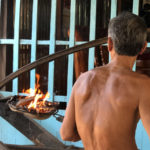
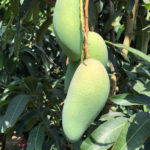


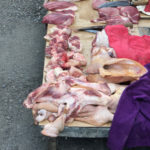

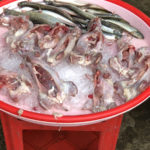
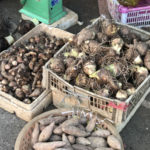
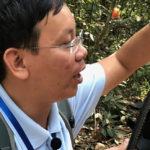
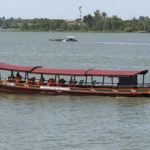 been anchored here all night off the cost, in the Mecong River. We took a ride in a XE LOI traditional Rickshaw using person power via bicycle and go for a visit to the
been anchored here all night off the cost, in the Mecong River. We took a ride in a XE LOI traditional Rickshaw using person power via bicycle and go for a visit to the 
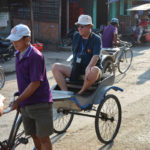 local rattan factory that produces baskets and mats. Most Vietnamese now sleep on mattresses so it will be interesting to hear about changing markets, probably beach mats in Europe, Asia ans the US.
local rattan factory that produces baskets and mats. Most Vietnamese now sleep on mattresses so it will be interesting to hear about changing markets, probably beach mats in Europe, Asia ans the US.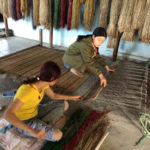










 We met a Grandpa San who’s name was “five” because his parents had so many children she could not keep track of thier names. He was a soldier in the ARV army during the war and was wounded in 1973 and returned to his village. After the war he was sent to a Communist reeducation camp for a year but he must have been on good behavior or a good actor becuse he was released in 6 months. I do not think he spoke English but was very interesed in his fellow veterans in the group. I’m sure there was a story there that would have been interesting to explore more.
We met a Grandpa San who’s name was “five” because his parents had so many children she could not keep track of thier names. He was a soldier in the ARV army during the war and was wounded in 1973 and returned to his village. After the war he was sent to a Communist reeducation camp for a year but he must have been on good behavior or a good actor becuse he was released in 6 months. I do not think he spoke English but was very interesed in his fellow veterans in the group. I’m sure there was a story there that would have been interesting to explore more.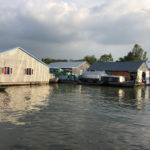
 We visited a Talipia Farm where the family operations make an after expenses income of $30,000 which is a excellent income. They produce two crops of fisk per year, it takes 5 months and grow about 350,000 fish per crop.
We visited a Talipia Farm where the family operations make an after expenses income of $30,000 which is a excellent income. They produce two crops of fisk per year, it takes 5 months and grow about 350,000 fish per crop. 
